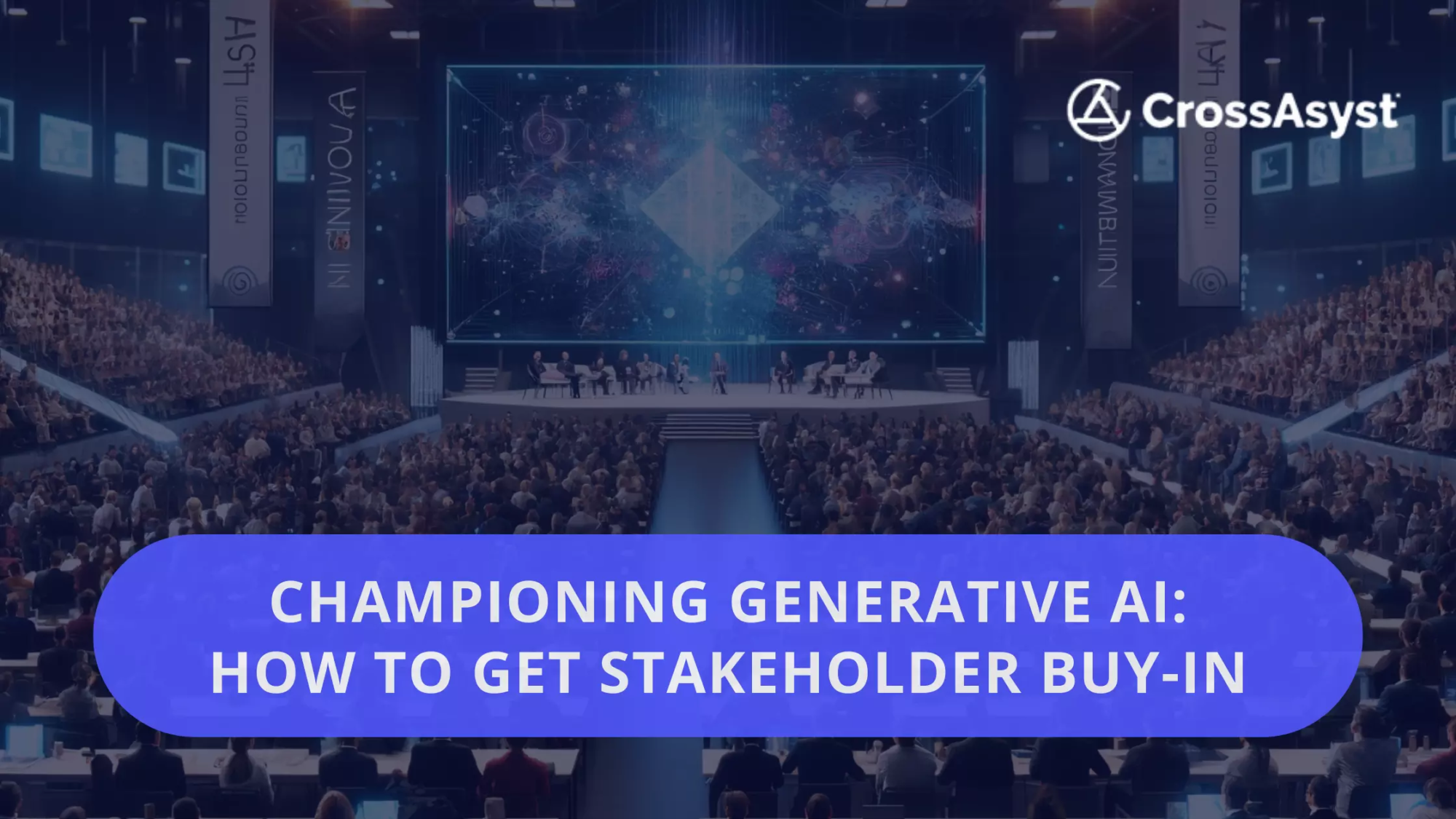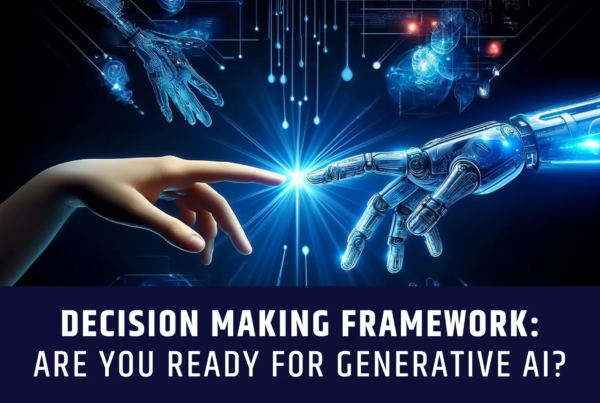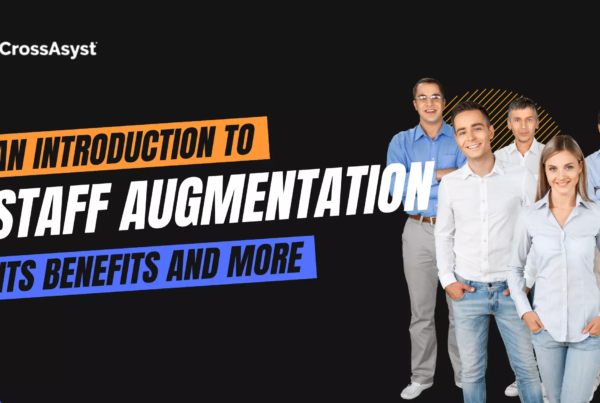Generative AI is quickly changing the way people work across industries. It’s helping people write content, program code, create at and so much more. It seems that people are discovering new ways to leverage the capabilities of generative AI to drive innovations every day.
It is, therefore, no wonder that generative AI had a market value of close to $45 billion by the end of 2023. However, not everyone seems to be keen on jumping onto this bandwagon.
A lot of traditionalists are skeptical about generative AI’s capabilities, and seem to even be threatened by its applications. This makes it essential to convince all stakeholders that adopting this new technology is more beneficial than detrimental.
If you’re in an organization where generative AI needs a strong advocate, this blog is just for you. Here’s how you can champion generative AI in your organization and get stakeholders to buy into its adoption.
Table of Contents
Understanding Generative AI
Generative AI refers to a subset of artificial intelligence that focuses on creating data or content, rather than simply processing or analyzing existing information.
This technology has applications across various domains, from generating text and images to designing products and optimizing processes. Its ability to mimic human creativity and produce novel outputs makes it a powerful tool for innovation and problem-solving.
Benefits of Implementing Generative AI
An important part of convincing stakeholders that a disruptive, new technology like generative AI is worth investing in is convincing them of its benefits. Here are some of the most compelling benefits for any business to adopt generative AI.

Streamlining Workflows
Generative AI can automate repetitive tasks and streamline processes, reducing manual effort and increasing operational efficiency.
Enhancing Productivity
By handling routine tasks, Generative AI frees up employees’ time to focus on more strategic and creative endeavors, ultimately boosting productivity across the organization.
Driving Innovation
Generative AI has the capacity to generate novel ideas, designs, and solutions, sparking innovation and enabling organizations to stay ahead of the competition in rapidly evolving markets.
Improving Decision-Making
Through data analysis and pattern recognition, Generative AI can provide valuable insights to inform decision-making processes, leading to more informed and effective strategies.
Personalizing Customer Experiences
By analyzing customer data and preferences, Generative AI can create personalized content and recommendations, enhancing customer satisfaction and loyalty.
Importance of Stakeholder Buy-In
While the benefits of generative AI may be many, and compelling, adopting it as a part of existing workflows is bound to fail if all the stakeholders within the organization do not have faith in its abilities. Here’s a closer look at why stakeholder buy-in is crucial.
Alignment with Organizational Goals
Stakeholder buy-in ensures that Generative AI initiatives are aligned with the broader goals and objectives of the organization. When key stakeholders support the adoption of Generative AI, it becomes easier to integrate these initiatives into existing business strategies and processes.
Resource Allocation
Stakeholders, including executives and department heads, control the allocation of resources such as budget, personnel, and time. Their buy-in is essential for securing the necessary resources to implement Generative AI effectively. Without their support, initiatives may struggle to obtain the required funding or manpower.
Overcoming Resistance and Skepticism
Generative AI may face resistance or skepticism from employees who are unfamiliar with the technology or concerned about its potential impact. Stakeholder buy-in helps to overcome these barriers by providing credibility and endorsement from leadership, fostering trust and confidence among employees.
Driving Organizational Change
Implementing Generative AI often requires organizational change, including adjustments to workflows, roles, and processes. Stakeholders play a crucial role in driving and managing this change, ensuring that the organization can adapt and evolve successfully.
Advocacy and Support
Stakeholders act as advocates for Generative AI within the organization, promoting its benefits and advocating for its adoption. Their support lends credibility to the initiative and encourages broader acceptance and participation from employees at all levels.
Risk Mitigation
Stakeholder involvement helps to identify and mitigate risks associated with Generative AI implementation. By engaging stakeholders in the planning and decision-making process, organizations can address potential concerns and challenges proactively, reducing the likelihood of project failures or setbacks.
Challenges and Misconceptions
As a champion of generative AI, you can expect some stiff opposition while advocating for its adoption. Here are some of the key challenges you are likely to face.
Concerns about Job Displacement
One of the main challenges associated with Generative AI is the fear of job displacement among employees. There is a misconception that AI will replace human workers, leading to unemployment.
Quality of Generated Outputs
Another concern is the quality of outputs generated by Generative AI. There may be skepticism regarding the accuracy, relevance, and appropriateness of the content produced by AI algorithms.
Ethical and Bias Considerations
Generative AI algorithms may inadvertently perpetuate biases present in the training data, leading to ethical concerns regarding fairness and discrimination in decision-making processes.
Integration and Implementation Complexity: Implementing Generative AI solutions within existing organizational infrastructure can be complex and challenging, requiring significant time, resources, and expertise.
Regulatory and Compliance Issues
Organizations must navigate regulatory frameworks and compliance requirements when deploying Generative AI solutions, ensuring adherence to data privacy and security regulations.
Strategies for Gaining Stakeholder Buy-In
Here are some handy strategies to help you convince stakeholders that implementing generative AI in your organization is essential.

Addressing Concerns about Job Security
- Emphasizing Upskilling and Reskilling: Organizations can alleviate fears of job displacement by highlighting the opportunities for upskilling and reskilling that Generative AI initiatives present.
By investing in employee development programs focused on Generative AI technologies, organizations demonstrate their commitment to helping employees adapt and thrive in the evolving digital landscape.
- Promoting Lifelong Learning: Encouraging employees to embrace continuous learning fosters a culture of resilience and adaptability.
Training programs tailored to Generative AI equip employees with the skills needed to leverage AI effectively, ensuring their long-term employability and competitiveness.
- Redefining Roles and Responsibilities: Empowerment through Redefined Roles: Redefining roles to leverage Generative AI’s capabilities empowers employees to take on more strategic and value-added tasks.
Employees are encouraged to view AI as a tool that enhances their productivity and effectiveness in their roles, rather than a threat to their jobs.
- Encouraging Ownership and Creativity: Involving employees in the design and implementation of Generative AI solutions fosters a sense of ownership and creativity.
Employees are encouraged to explore new ways of leveraging AI to solve problems and drive innovation within their teams and departments.
Investing in Employee Upskilling and Reskilling
- Tailored Training Programs: Customized training programs equip employees with the specific skills needed to leverage Generative AI effectively.
These programs should be accessible, interactive, and relevant to employees’ roles, enabling them to apply their newfound knowledge directly to their work.
- Promoting a Culture of Continuous Learning: Emphasizing the importance of continuous learning and professional development fosters a culture of innovation and adaptability.
Employees are encouraged to embrace new technologies and acquire new skills throughout their careers.
Encouraging Cross-Functional Collaboration
- Breaking Silos: Encouraging collaboration between departments facilitates the integration of Generative AI into various business processes.
Cross-functional teams can share knowledge, expertise, and resources, leading to more effective implementation and utilization of Generative AI solutions.
- Knowledge Sharing and Interdisciplinary Cooperation: Cross-functional collaboration encourages knowledge sharing and interdisciplinary cooperation, enabling organizations to leverage diverse perspectives and skill sets in their AI initiatives.
This collaborative approach fosters innovation and accelerates the adoption of Generative AI across the organization.
Practical Steps for Championing Generative AI
Here are some practical ways for you to go about championing generative AI in your organization.
- Conducting stakeholder analysis and identifying influencers within the organization is the first step towards securing buy-in for Generative AI initiatives. By understanding stakeholders’ perspectives, concerns, and priorities, organizations can tailor their approach and communication strategies accordingly.
- Developing a compelling business case for Generative AI is essential for persuading stakeholders of its value and potential impact on organizational goals and objectives. Highlighting specific use cases, anticipated benefits, and return on investment can help garner support from decision-makers and allocate resources effectively.
- Creating a communication plan to engage stakeholders throughout the implementation process is crucial for building trust and fostering transparency. Providing hands-on demonstrations and pilot projects allows stakeholders to experience the benefits of Generative AI firsthand and address any concerns or reservations.
- Securing support from leadership is pivotal for championing Generative AI within organizations. By obtaining buy-in from senior executives and securing their commitment to the initiative, organizations can overcome resistance and drive meaningful change.
Build Future-Ready Software With CrossAsyst
We at CrossAsyst firmly believe in building software that is future-ready. Our team will soon be offering a full suite of custom software solutions that feature the power of generative AI.
Of course, our clients can also rest easy, knowing that our team’s commitment to go above and beyond during every step of the process of building their software solutions: from ideation and planning to launching the finished software and more.
Get in touch with CrossAyst today to learn more about custom software development services.




